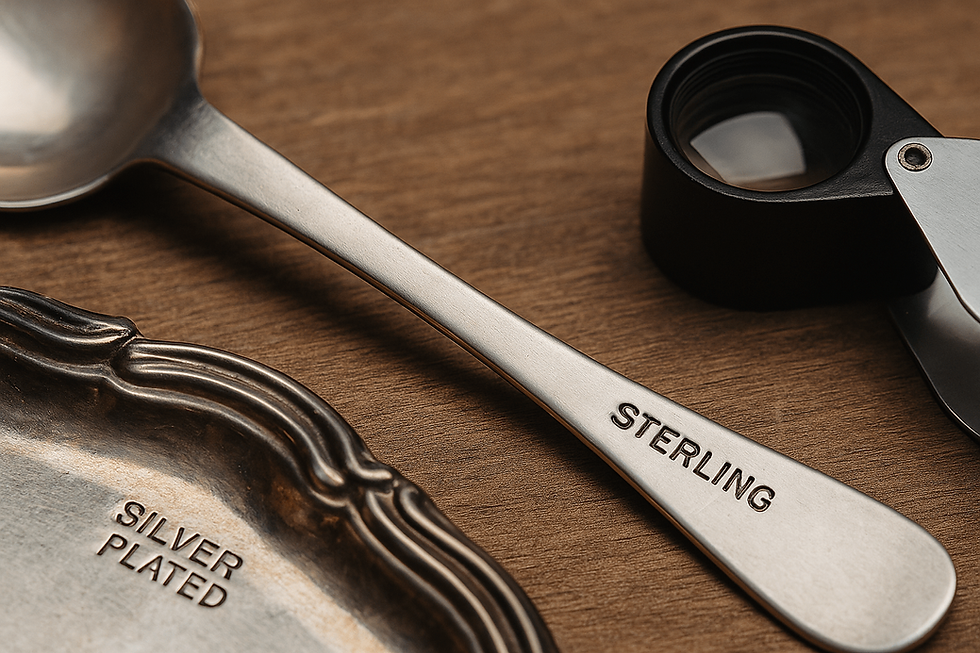Sterling Silver vs Silver-Plated: How to Know What You Have (and What It’s Worth)
- Darryl Gaye

- Nov 10
- 3 min read
If you have old silverware, jewelry, or decorative pieces tucked away in a drawer, the first question most people ask is the same: Is this real sterling silver or just silver-plated? The difference matters more than most realize. Sterling silver contains real silver and carries true melt value, while silver-plated items only have a thin coating of silver on top of a base metal. They may look similar, but their value can be dramatically different.
The good news is that with a few simple observations, you can get a strong idea of what you have before bringing it in for a professional evaluation.

What “Sterling Silver” Really Means
Sterling silver is traditionally made of 92.5% real silver, with the remaining metal (usually copper) added for strength. This is why sterling silver pieces are typically stamped with 925, .925, 92.5, STERLING, or a similar hallmark. These marks indicate that the piece contains real silver that can be refined and reused, which gives it real resale value.
Silver-plated items look like sterling, but they have very little silver content. They are made primarily from metals such as nickel, brass, or copper, coated in a thin flash of silver. Once that thin layer wears off, there is no meaningful silver left to recover — which is why silver-plated items generally aren’t bought based on metal value.
How to Identify Sterling Silver at Home
One of the easiest ways to start identifying silver is by examining the hallmarks. Flip the piece over or look underneath for small stamped numbers or letters. “925,” “Sterling,” or “Ster.” are all indications that the item is sterling silver. In contrast, marks like “EP,” “EPNS,” “Silver Plate,” or “SP” point to silver-plated construction.
Weight can also be a clue. Sterling silver tends to feel heavier and denser than silver-plated items of the same size. For example, two serving spoons may look identical from a distance, but the sterling one will usually have a noticeable weight difference when held in the hand.
The magnet test is another simple starting point. Real silver is not magnetic. Holding a strong magnet near the piece won’t confirm authenticity on its own, but if the item sticks firmly, it’s almost certainly not sterling.
Finally, tarnish can tell a story. Sterling silver develops a deep grey or black patina that polishes away cleanly. When silver-plated items tarnish and the top layer wears down, the underlying metal can show through — sometimes leaving greenish discoloration or revealing copper tones beneath. When you see another metal underneath, that's a clear sign that the item is silver-plated.
Understanding Value: What’s Worth Selling?
Sterling silver items, especially flatware, serving pieces, tea sets, jewelry, and older decorative pieces, typically hold meaningful resale value because of their real silver content. Even if they’re worn, mismatched, or slightly damaged, the silver itself can be refined and reused — which is what gives these items their melt value.
Silver-plated items, by contrast, generally don’t have much metal value at all. They may still have design, collectible, or sentimental value, but they usually aren’t eligible for melt-price resale because the silver content is too thin to recover.
That said — many people are surprised by how much value sterling silver items can hold when weighed and priced properly, especially complete flatware sets, heavy serving trays, and vintage jewelry.
When It Makes Sense to Get a Professional Evaluation
Even with careful at-home checks, some pieces aren’t straightforward — especially antiques, foreign markings, inherited items, and mixed sets. That’s where a professional evaluation is useful.
At American Gold & Diamond Buyers, we test pieces right in front of you, using accurate and non-destructive tools such as XRF composition analyzers and authenticated hallmark guides. You’ll see exactly what your item is made of — not an estimate, not a guess — and we’ll explain how its value is determined based on purity, weight, and the current market price of silver.
There is no pressure to sell. Many people simply want clarity — and walk away feeling more informed about what they own.
Final Thoughts
Learning the difference between sterling silver and silver-plated pieces puts you in control. It helps you avoid disappointment, prevents you from overlooking items that are valuable, and gives you confidence when deciding whether to sell.
If you have silverware, jewelry, or silver pieces you’re curious about, we’re here to help. Bring your items in for a free, transparent evaluation — whether you have one piece or a whole collection.
Want to find out what your silver is worth? Schedule or walk in anytime — no appointment needed.











Comments